If I have an onion, I can make soup. But I usually add much more than that to my pot. The soupe du jour at chez Bonneau depends on what else I find in the refrigerator and pantry.
Soup is part of the solution
Last week in California, we reached a grim and insomnia-inducing milestone: our first gigafire, as in one raging fire that has surpassed 1,000,000 acres in size. One fire. By comparison, the terrifying 2018 Camp Fire that razed the town of Paradise burned 153,335 acres. We actually needed the new gigafire classification for the seven-figure August complex fire. Megafire—over 100,000 acres—is so 2019.
Cooking a pot of soup may seem futile when faced with such depressing news. However, when Project Drawdown, a highly respected resource on climate solutions, released an update earlier this year, it listed reduced food waste as the number one solution to stopping climate change. (This is under the scenario of keeping heating below 2 degrees Celsius.)
Wasting food wastes not only the food itself but also all of the resources that went into producing it: water, energy, land, labor, capital and so on. When that wasted food decomposes anaerobically in a landfill, it releases methane gas, a greenhouse gas that warms the planet at a rate 86 times greater than carbon dioxide over a 10- to 20-year period.
With the average US household wasting 31.9 percent of its food, your pot of soup made with this and that before the food becomes waste not only tastes good but does good.
A basic soup formula
For a couple of soup workshops I recently taught, attendees Zoomed in from their kitchens, brought whatever random vegetables they had on hand and we all cooked a pot of soup together. We prevented food waste by cooking those last bits, we saved money and no two pots tasted alike. We followed my basic non-recipe recipe below.
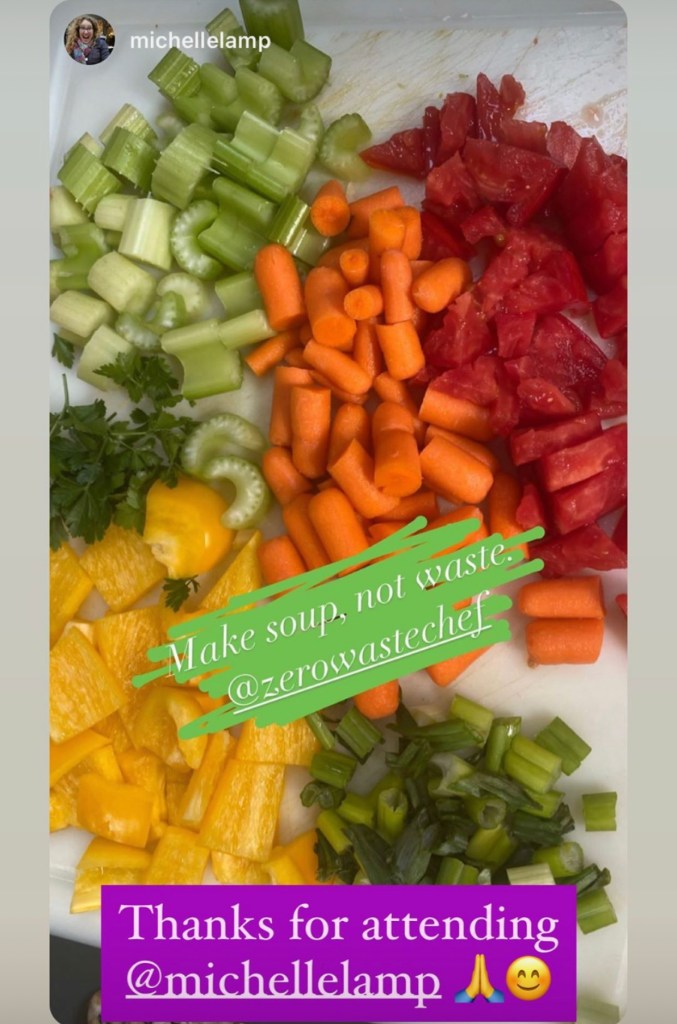
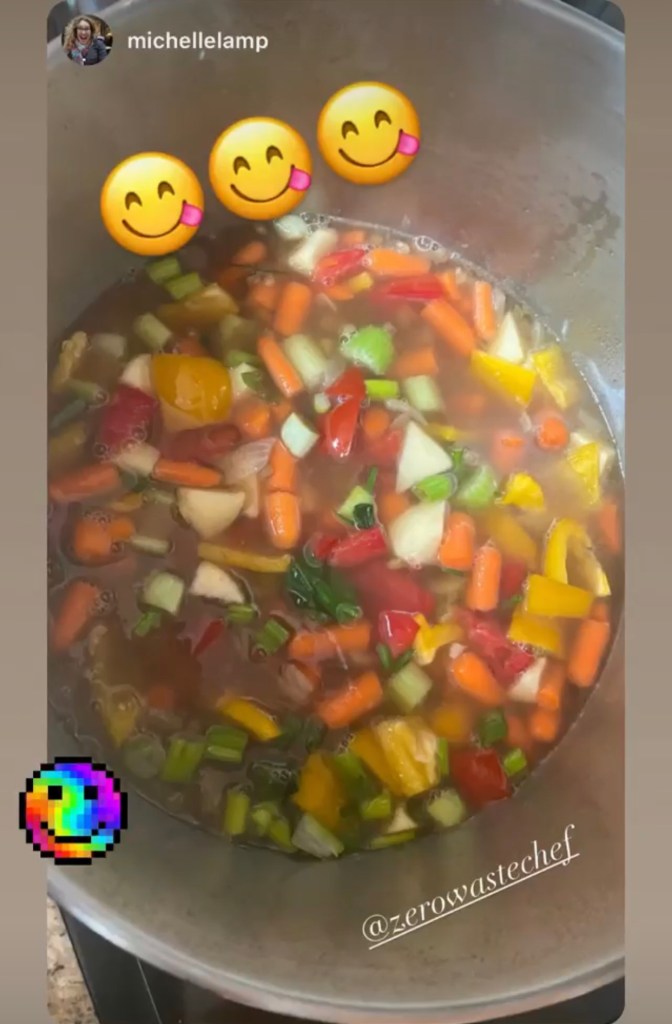
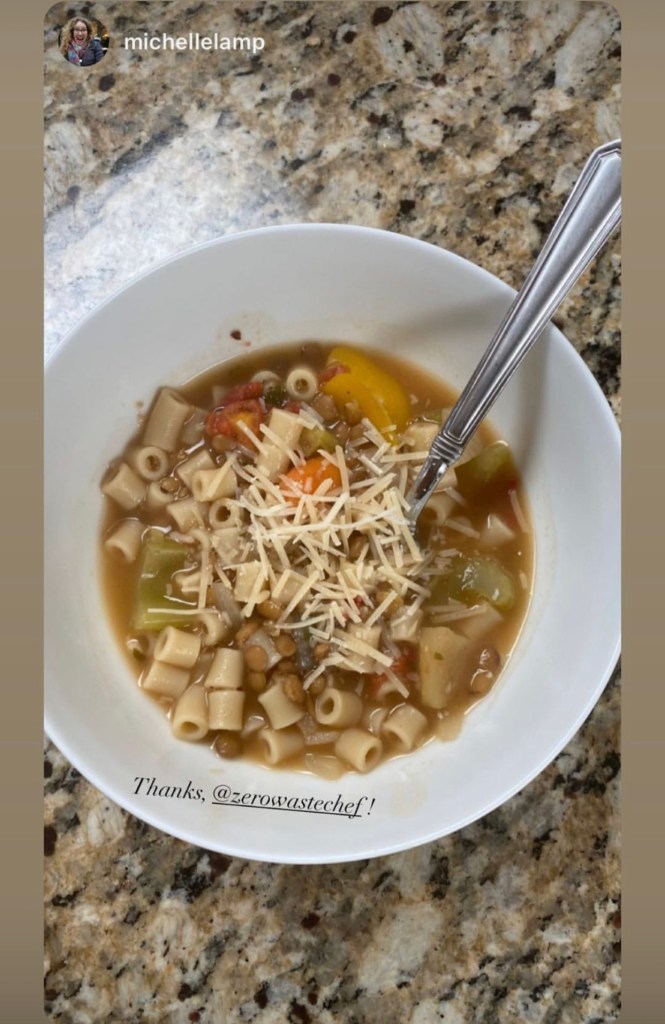
Add fat to a large Dutch oven or stock pot
I use olive oil. For a large pot of soup in my 6 3/4 quart Dutch oven, I’ll use 3 or 4 tablespoons.
Sauté an onion
Or sauté shallots or leeks or a combination of Allium family members (including garlic). Sauté on medium-low heat until the onions become translucent, about 5 to 10 minutes.
One class attendee said she chops up parsley stems and adds them early on to her soup. Parsley stems have a much stronger flavor than the leaves so this is a great way to eat them. Always be sure to taste your random soup as you go.
Add fresh herbs
Fresh herbs go in at the beginning. If you have dry herbs, add them near the end. I love to add fresh rosemary to my soup. If you have a yard, a rosemary plant is a wonderful thing to grow. This perennial gives and gives and gives with little to no maintenance (aside from watering it once in a while).
In my classes, I added dried thyme to my soup because I had quite a bit of it. Other options include oregano, marjoram and rosemary—dried or fresh. Add some of each if you prefer.
Sauté sliced mushrooms if you have them
You want to add these early to caramelize them and release liquid. Mushrooms add tons of flavor to soup—or any savory dish really.
If you’re adding tomatoes, add them now
Break them up with the back of a wooden spoon and cook for about 5 to 10 minutes until cooked down. In my recent Zoom classes, I used roasted tomatoes that I had frozen last summer.
Add tomato paste if you have any
Tomato paste add lots of flavor when you add it early. Stir and cook it for a few minutes to caramelize it. Caramelization concentrates the sugars and renders a more complex flavor. Once it turns from bright red to more of a brick red, move onto the next step. (Go here for tips to use every last spoonful of tomato paste.)
Add cheese rinds if desired
If you eat Parmigiano-Reggiano, save those rinds and toss a couple into your soup. They add lots of flavor.
If you soaked beans, drain, rinse and add them to the pot
Beans cooked from dried add so much flavor. If you soak them first, they will cook more evenly, especially if they are older—and bean age is difficult to determine. Add them to the pot.
Cover your beans with water, vegetable broth or bean broth. When I cook beans in my pressure cooker, I save that bean broth. It adds flavor and thickens soups. (Water your plants with the water you soaked the beans in as consuming that can make you gassy.)
Cover the beans with a few inches of your liquid of choice. Now cover the pot with the lid. Bring the beans to a boil, then turn them down to a simmer. Cook for about an hour until tender.
Add salt and dry herbs
After you’ve added the water or broth, add salt and any dried herbs. In my large vat of soup, I’ll start with a teaspoon or two of salt. After tasting later, I may add more.
Add the random vegetables and, if using, dry grains and cooked beans
In the first class, I added sweet potatoes, celery, one chopped apple (honestly, a bit of apple tastes good and doesn’t make your soup taste at all apple-y) and hominy (cook dry hominy first) to my soup. Those added up to about 8 cups of chopped vegetables. If you have greens like kale or spinach, save those for the very end.
I also added 1/4 cup of uncooked farro. Soup loves mystery grains.
If you opted for cooked beans, add those now.
Add more water or broth if necessary to cover the ingredients. Bring the pot to a boil, then turn the heat down to simmer. Cover and cook for 15 to 20 minutes until the vegetables are tender.
Add leafy greens, if using
These wilt so quickly that I add them at the very end of cooking my soup.
Season the soup
You’re just about done! Add an acid—vinegar (I add wine vinegar), lemon juice, preserved lemon juice or lime juice. Do not skip the acid. It makes a huge difference and brightens the soup’s flavor. Taste and add more acid, salt or pepper as needed.


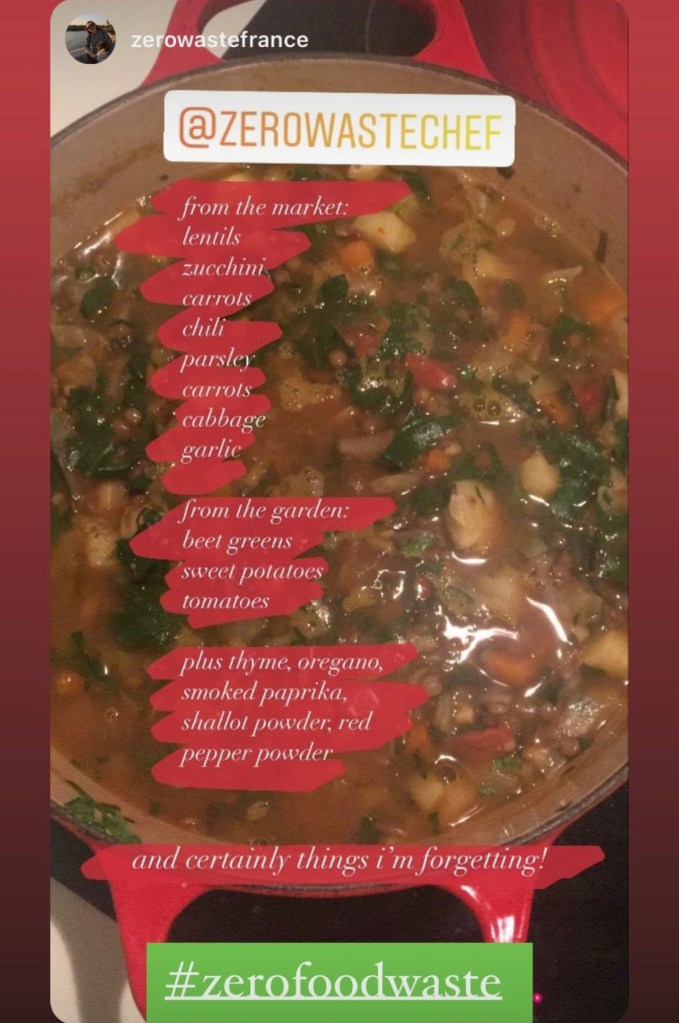
Shop-the-Fridge Soup
Ingredients
- 3 to 4 tablespoons oil
- 2 onions, minced
- 2 cloves garlic, minced
- 1 tablespoon dried herbs, such as thyme, oregano, marjoram, rosemary or a combination or use a smaller amount of fresh herbs
- 2 cups sliced mushrooms optional
- 2 tablespoons tomato paste optional
- 2 cups chopped tomatoes optional
- 2 cups dried beans, such as pinto, cannellini or borlotti beans, soaked for at least 6 hours or up to 14 hours, drained and rinsed, or 4 cups cooked beans optional
- 8 to 10 cups water, vegetable broth, bean broth, or a combination
- 2 Parmigiano-Reggiano cheese rinds optional
- 8 cups bite-size pieces of random vegetables, such as carrots, celery, bell peppers, cauliflower, potatoes, sweet potatoes, parsnips, turnips, bell peppers, squash, zucchini or pumpkin
- 2 cups torn leafy greens, such as kale or spinach optional
- ¼ to ½ cup orzo, wheat berries or other dry grains or add cooked grains at the end to heat through
- salt to taste
- pepper to taste
- 1 to 2 tablespoons vinegar or lemon juice, or to taste
Instructions
- In a large Dutch oven or stock pot, sauté the onions and garlic in olive oil over medium-low heat until translucent, about 5 to 10 minutes. Add any fresh herbs and stir for 1 minute.
- If using, add mushrooms and sauté until the water is released and they brown, about 5 minutes.
- Add tomatoes, if using. Break them up with the back of a wooden spoon and cook for about 5 to 10 minutes until cooked down.
- If using tomato paste, add now, cook and stir for a few minutes until it turns from bright red to brick red.
- Add soaked beans, if using. Cover them with 3 inches of water or broth. If you are adding cheese rinds, add them now. Add salt and any dried herbs. Cover the pot with the lid. Bring the beans to a boil, then turn them down to a simmer and cook covered for about an hour until tender. Stir occasionally while they cook.
- Add chopped vegetables and, if using, dry grains and cooked beans. Add more water or broth to cover the ingredients. Bring them to a boil, then turn down to simmer. Cover and cook for 15 to 20 minutes until the vegetables are tender.
- At the end of cooking, add any leafy greens.
- Season the soup to taste with vinegar or lemon juice. Taste and add more vinegar or salt or pepper if needed.

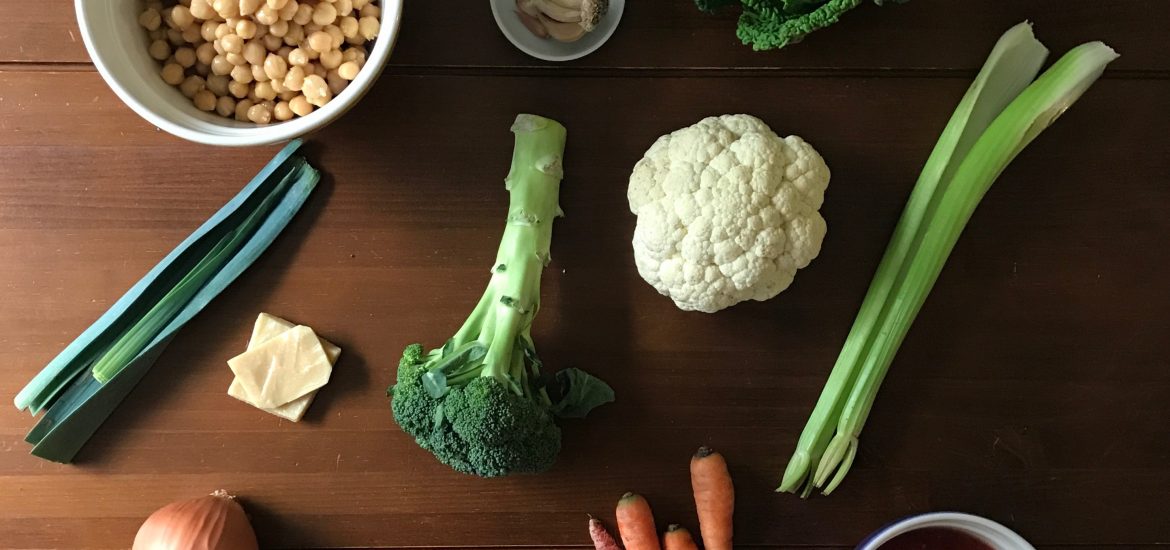


There is nothing like a bowl of homemade soup I always keep some in my fridge…I like the tip on vinegar which I haven’t used but will try…Thank you for sharing 🙂
Hi Carol,
It’s always good to have some soup on hand. The vinegar makes a big difference and you only need a bit.
Enjoy your soup 🙂
Anne-Marie
Although I know how flavourful the bean cooking-water is, I’ve never thought of cooking the beans in the soup. This is such a great idea and I shall make this soup tomorrow night with my home-canned tomatoes and stuff from the fridge!
Oh that will be delicious with your tomatoes. Enjoy!
~ Anne-Marie
Love this – I definitely need to try out this recipe in the fall! 🙂
Jenna ♥
Stay in touch? Life of an Earth Muffin
Thanks Jenna. Enjoy!
~ Anne-Marie
I grew up on this soup and have passed it down to my kids. Only difference is we call this, “Clean the Refrigerator Soup”!
Hi Ellen,
Great name for the soup 🙂 Your kids are set. If I ran the world, I would make every schools teach kids how to make this!
~ Anne-Marie
I make All-In-The-Pot soup on the same general principle but also add various leftovers at the end: chopped cooked meat or vegetables, cooked grains, bits of soup or stew that aren’t enough for a full meal. It tastes very different depending on what there was to add, but it’s always tasty! I like to keep soup in the freezer for days I don’t have time to cook.
Yum.
I made this soup and it was delicious!! I used my homemade turkey stock and instead of beans I added in 3 cups of cooked barley that I had on hand. I have dried thyme, oregano & rosemary on hand so I put 1/2+ tsp of each in an herb bag along with 2 bay leaves. Thanks for the recipe!!
Yum! That sounds absolutely delicious. I love barley. Thanks for trying the soup recipe!